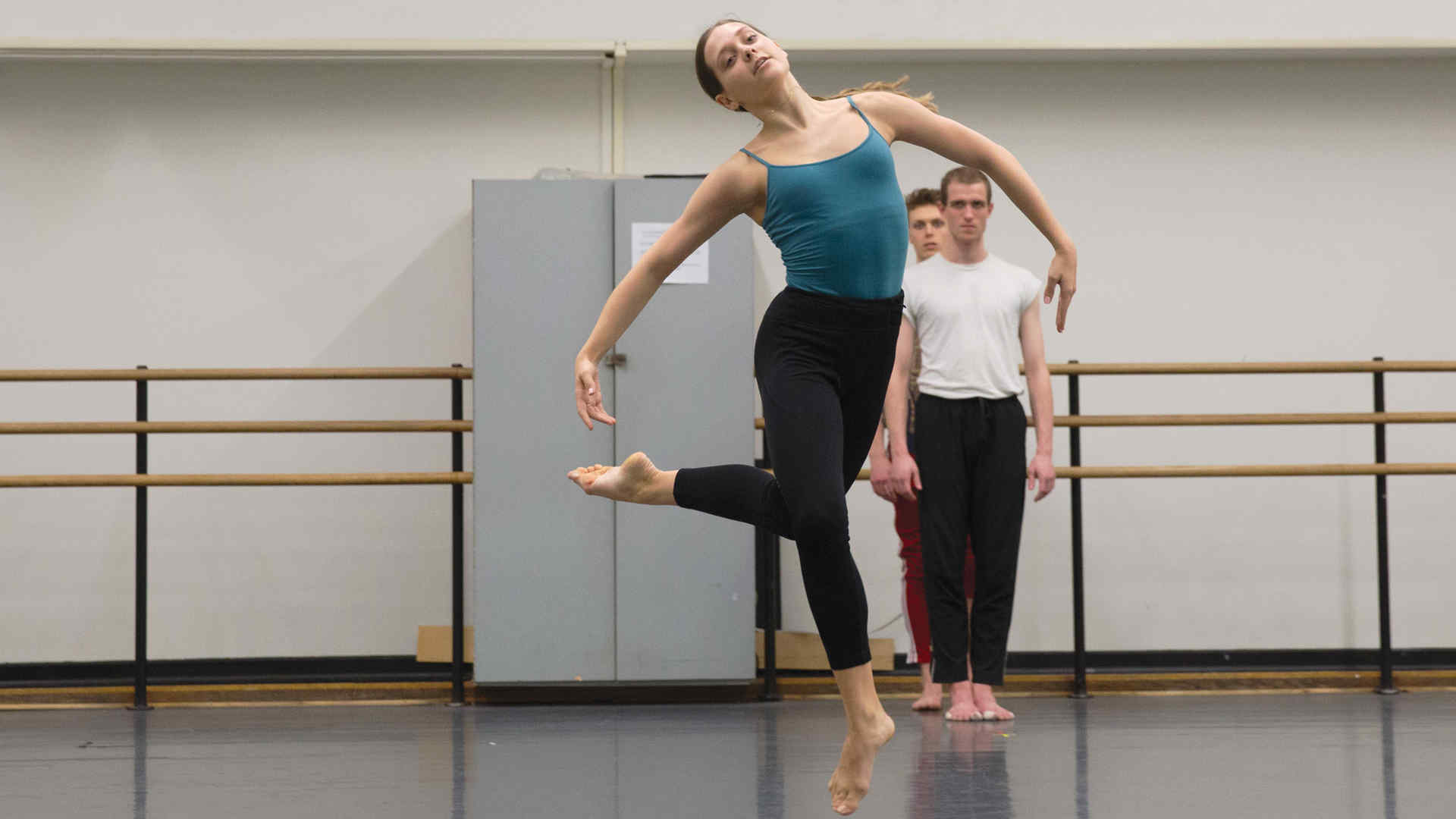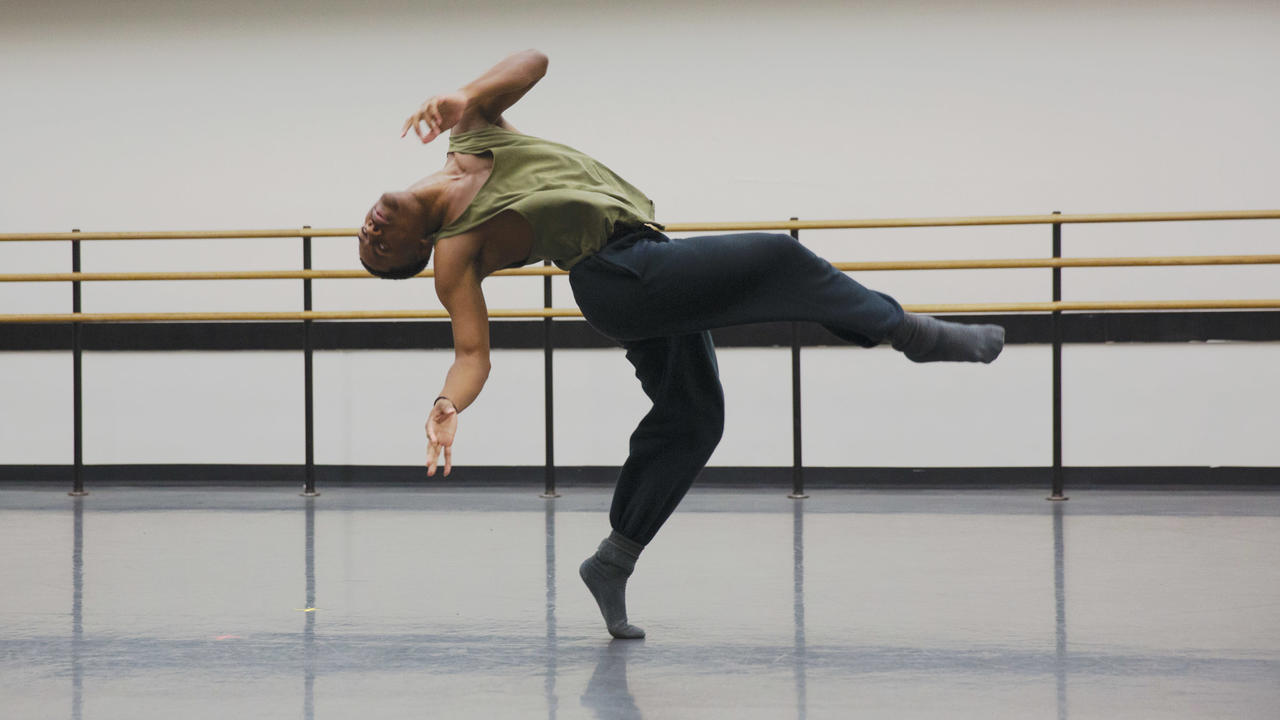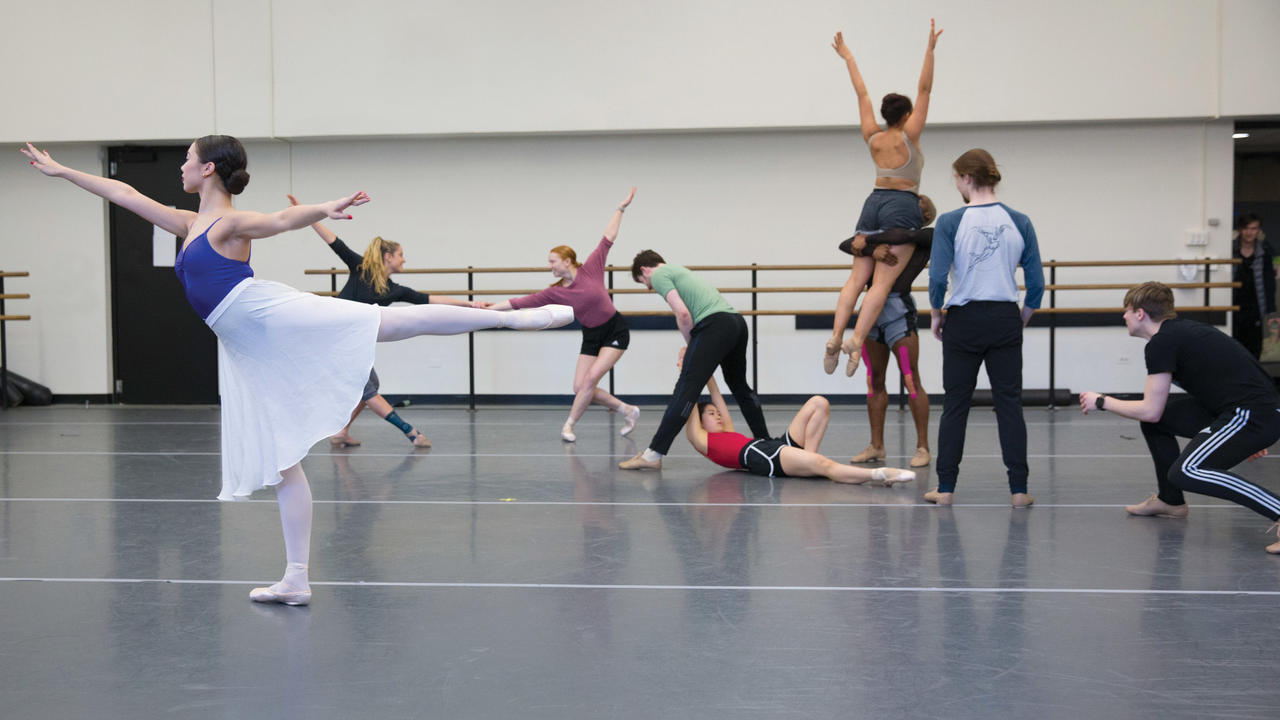
Juilliard’s Spring Dances program, in which second-, third-, and fourth-year dancers present repertory classics, takes place in late March. This year’s program includes Merce Cunningham’s Sounddance (1975), Crystal Pite’s Grace Engine (2012), and Twyla Tharp’s Deuce Coupe (1973). Three of the dancers spoke with their stagers about the works not long after rehearsals began.
Sounddance
“I’m not expressing anything. I’m presenting people moving.” —Merce Cunningham
Merce Cunningham’s technique is known for its difficulty of execution, and in his works, that difficulty level skyrockets into a piece that is best performed by only the most skilled of technicians. This year, former Cunningham dancer and current Juilliard faculty member Jean Freebury is setting Sounddance on the Dance Division.
The outside perspective: Sounddance is crazy. It’s a flurry of many fast-moving parts. It’s a test of both stamina and skill, as dancers are asked to accomplish difficult maneuvers at top speed—and to do so for the near entirety of the piece. Created by Cunningham in 1975, when he returned from an extended time away from his company, Sounddance is rooted in the excitement of working with his own dancers again. Like many of his other pieces, it focuses on physicality rather than musicality. The creative process is spent by the dancers in silence to ensure independence from outside stimulation.
The inside perspective: Sounddance is filled with small victories and the difficulty of building a community. As the dancers grapple with building fatigue, they begin to draw energy from the success of another difficult maneuver and encouragement from fellow dancers as awareness builds that this is not an individual struggle but a community-wide effort. Each dancer must share their energy with those next to them in order to receive the energy they need to keep going.
Fourth-year dancer Thomas Woodman holds Otto G. Storm and Jean S. Kaufman as well as Cara and Hiram Lewine scholarships

Grace Engine
Alexandra Damiani’s job in restaging Crystal Pite’s Grace Engine (2012) is to translate Pite’s intention, accuracy, and physicality to dancers who may not be familiar with this amazing work. Pite created it while associate choreographer for Cedar Lake Contemporary Ballet, where Damiani, who hails from France, was ballet master and artistic director. Since then Damiani’s relationship with Grace Engine has continued to grow and she recently reset it for Hubbard Street Dance Chicago.
Damiani’s approach to restaging this piece is fresh enough to incite a new magic in the Juilliard dancers at every rehearsal. She doesn’t just teach the steps—she explains how, why, and when a movement was created. That context is an important storytelling aspect of Grace Engine and all of Pite’s works. With that added knowledge we can dance from experience and sensation instead of memory-based expressions, and Damiani says that the piece will only be executed properly if we are always reinventing the “state of being. “Nothing is fixed in dance, we have to re-create it every time. The piece is still breathing.” Damiani is wholeheartedly devoted to the process and product, and creating a passionate environment for the dancers to “do the work now.” Grace Engine is fearless, demanding, and, in her words “magic.”
Fourth-year dancer Alysia Johnson holds William Randolph Hearst and Juilliard scholarships

Deuce Coupe
Twyla Tharp’s Deuce Coupe wildly remixes French imperial footwork against cool, swinging, Dionysian movement, showing how each complements and contrasts with each other. All of this is set to the gentle yet provocative music of the Beach Boys, making for a unique and unforgettable piece.
This year, Tharp asked Richard Colton to restage the piece at Juilliard (it was also performed here in 2007). Colton first met Tharp as a Deuce Coupe understudy at the Joffrey Ballet, in 1973, and he has restaged it a number of times since then. “It’s incredible to work on her pieces with a new generation, and I’ve been moved and impressed by the Juilliard dancers,” Colton said. As one of those dancers, I have to say his generosity and positivity are contagious and makes the complex process of learning the piece all the more enjoyable.
Colton talked about how Tharp “buoys dancers” with her unconditional belief in them, and how she constantly looks to see what is right with them. Her work relies on continued improvisation and play from every dancer throughout this rigorous piece.
Colton often references the turbulent 1960s in our Deuce Coupe rehearsals. While there was hopefulness, beneath it was “a sense of loss, a sense of fear and anxiety, and a sense of maturity for seeing things for what they were.” The improvised structures that make up most of Deuce Coupe force the dancers to be hyperaware as they navigate complicated movement sequences and clever variations that feel like a childhood game and a life-or-death situation. That’s the element of the ’60s that shines through—the desperate attempt to regain a childlike view of a tragic and scary world. The single ballerina in white remains a calm constant throughout the turmoil of the piece, giving a reassuring sense of stability; the wild structures superimposed against classical vignettes hint at a structure and clarity under the chaotic surface.
Colton feels a similar loss of faith in our society today. “In the ’60s people’s politicization—their anger and connection— became a second stage. I think Deuce Coupe has that sense of a collective. We are finding kindred spirits on the stage; the music gathers us. It’s a wonderful piece for this moment, for its entertainment and joyfulness, but also for its defiant energy.”
Second-year dancer Nicolas Noguera holds Norman and Rosina Winston as well as Josef and Melinda Romon scholarships